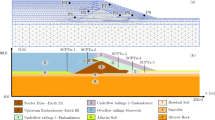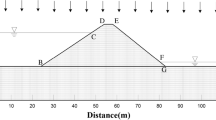Abstract
Levee foundations along meandering rivers are often modeled in seepage analyses with simplified models consisting of two layers having uniform thickness and soil properties. While this may simplify the analysis and allow for use of simplified reliability methods, it is important to realize the limitations of these simplifying assumptions. Due to the complex geomorphic regime that is often encountered in the fluvial environment, levee foundation geometry can range from simple to very complex. Variations in layer thickness and continuity affect the pore pressure and seepage regime and, consequently, affect the potential for internal erosion of the foundation soils. A study has been performed to assess the effects of complex subsurface geometry on the susceptibility of levees to underseepage related internal erosion. Reliability-based internal erosion analyses have been performed on eight hypothetical levee profiles using two analytical methods. The first-order second-moment-blanket theory (FOSM-BT) method applies a simplified reliability assessment technique to the US Army Corps of Engineers “Blanket Theory” equations. This method requires that the analysis profile be simplified to meet the requirements of the equations and places limitations on how the uncertainty of the various input parameters is modeled. The more complex response surface-Monte Carlo simulation method is capable of modeling more complex geometries and multiple failure modes and is flexible in how uncertainty of the various input parameters are modeled. The results of the two methods are compared to evaluate the effectiveness of the FOSM-BT in evaluating internal erosion potential in increasingly complex levee foundation conditions.











Similar content being viewed by others
References
Armitage P, Berry G, Matthews JNS (2008) Statistical methods in medical research. Wiley, Chichester
Baecher GB, Christian JT (2003) Reliability and statistics in geotechnical engineering. Wiley, Chichester
Bligh WG (1910) Dams, barrages, and weirs on porous foundations. Eng News 64(26):708–710
Bligh WG (1913) Lessons from the failure of a weir and sluices on porous foundations. Eng News 69(6):266–270
Bligh WG (1915) Submerged weirs founded on sand. In: Bligh WG (ed) Dams and weirs. American Technical Society, Chicago, pp 151–179
Brandon TL, Batool A, Jimenez M, Vroman ND (2013) Draft: levee seepage analysis using blanket theory and finite element analysis. Report submitted to the US Army Corps of Engineers, Vicksburg District, by the Department of Civil and Environment Engineering Virginia Tech
Bridge J (2003) Rivers and floodplains: forms, processes, and sedimentary record. Blackwell Publishing, Oxford
Brierley GJ, Fryirs KA (2005) Geomorphology and river management: applications of the river styles framework. Blackwell Publishing, Oxford
Cameron AC (2009) EXCEL 2007: multiple regression, handout. Department of Economics, University of California UCDAVIS. http://cameron.econ.ucdavis.edu/excel/ex61multipleregression.html. Accessed 7 Jan 2014
Chatterjee S, Simonoff JS (2013) Handbook of regression analysis. Somerset, Wiley
Duncan MJ (2000) Factors of safety and reliability in geotechnical engineering. J Geotech Geoenviron Eng ASCE 1264:307–316
Filgueira-Rivera M, Smith ND, Slingerland RL (2007) Controls on natural levée development in the Columbia River. Sedimentology 54:905–919
Fryirs KA, Brierley GJ (2013) Geomorphic analysis of river systems. Wiley-Blackwell, Oxford
Glynn ME, Kuszmaul J (2010) Prediction of piping erosion along middle Mississippi River levees: an empirical model. USACE, Technologies and Operational Innovations for Urban Watershed Networks Research Program, ERDC/GSL TR-04-12. Originally published in 2004 and revised in 2010
Harr ME (1987) Reliability-based design in civil engineering. McGraw-Hill, New York
ICOLD (2012) Internal erosion of existing dams, levees, and dikes, and their foundations—international glossary. CIGB-ICOLD Bull, 1
Kanning W (2012) The weakest link. Dissertation, Delft Technical University. http://repository.tudelft.nl/search/ir/?q=isbn%3A%229789461860880%22 Accessed 7 Jan 2014
Lane EW (1935) Security from under-seepage: masonry dams on earth foundation. Trans ASCE 100(1):1235–1272
Lopez de la Cruz J, Calle EOF, Schweckendiek T (2011) Calibration of piping assessment models in the Netherlands. Paper presented at the ISGSR 2011: 3rd international symposium on geotechnical safety and risk, Munich, Germany, 2–3 June 2011. ISBN 978-3-939230-01-4
Low BK (2008) Reliability of levee systems. In: Phoon K-K (ed) Reliability-based design in geotechnical engineering. Taylor & Francis Group, New York, pp 134–168
Meehan CL, Benjasupattananan S (2012) An analytical approach for levee underseepage analysis. J Hydrol Elsevier 470–471:201–211. doi:10.1016/j.jhydrol.2012.08.050
Möllmann AFD, Vermeer PA (2007) Reliability analysis of a dike failure. Paper presented at the 18th European Young Geotechnical Engineers’ Conference EYGEC, Ancona, Italy, June 2007
Palisade Corparation (2013) @Risk 6.1. Integrated Excel program that performs risk analysis using Monte Carlo simulation
Polanco L, Rice J (2010) Reliability based underseepage analysis in levees using Monte Carlo simulation. Paper presented at the 2010 ASDSO conference, concurrent session IV: engineering solutions for levees, 19–23 Sept 2010
Polanco L, Rice J (2011) Reliability based underseepage analysis in levees using Monte Carlo simulation. Paper presented at the 2011 ASCE GeoFrontiers Conference, Paper #2978, 13–16 March 2011
Rice J, Polanco L (2012) Reliability-based underseepage analysis in levees using a response surface-Monte Carlo simulation method. J Geotech Geoenviron Eng ASCE 138(7):821–830
Ritter DF, Kochel RC, Miller JR (2011) Process geomorphology, 5th edn. Waveland Press, Illinois
Saucier RT (1994) Geomorphology and quaternary geologic history of the lower Mississippi valley. U.S. Army Engineer Waterways Experiment Station, Vicksburg, Mississippi, vol 1, p 414
Sellmeijer JBA (1988) On the mechanism of piping under impervious structures. Dissertation, Delft Technical University, Delft, The Netherlands. http://repository.tudelft.nl/view/ir/uuid%3A7f3c5919-1b37-4de9-a552-1f6e900eeaad/ Accessed 7 Jan 2014
Sleep M, Duncan MJ (2008) Manual for geotechnical engineering reliability. Report by Virginia Tech Center for Geotechnical Practice and Research, Blacksburg
Smith ND, Pérez-Arlucea M (2008) Natural levee deposition during the 2005 flood of the Saskatchewan River. Geomorphology 101:583–594
Steenbergen HMGM, Lassing B, Vrouwenvelder ACWM, Waarts PH (2004) Reliability analysis of flood defence systems. Heron 49(1):51–73
Terzaghi K (1922) Der Grundbruch an Stauwerken and seine Verhiltung (Includes English translation: Piping in Dams and Its Prevention). Die Wasserkraft 1724:445–449
Terzaghi K, Ralph P (1948) Soil mechanics in engineering practice. Wiley, New York
USACE (1956) Investigation of underseepage and its control. TM No. 3-424, U.S. Army Engineer Waterways Experiment Station, Vicksburg, MS
USACE (2000) Design and construction of levees. Engineering Manual EM 1110-2-1913, U.S. Army Core of Engineers, Washington, DC
USACE (2003) Design and construction of levees. Risk-based analysis in geotechnical engineering for support of planning studies. ETL 1110-2-556, Appendix B: evaluating the reliability of existing levees, U.S. Army Core of Engineers, Washington, DC
USACE (2004) Geotechnical reliability of dam and levee embankments. ERDC/GSL CR-04-1, Geotechnical and Structural Laboratory, U.S. Army Core of Engineers, Washington, DC
USACE (2005) Engineering and design: design guidance for levee underseepage. ETL 1110-2-569, U.S. Army Core of Engineers, Washington, DC
Van Beek V, Yao Q, Van M, Barends F (2012) Validation of Sellmeijer’s model for backward piping under dikes on multiple sand layers. Presented at the ICSE6: sixth international conference on Scour and Erosion, Paris, 27–31 August 2012
Vrouwenvelder T (2006) Spatial effects in reliability analysis of flood protection systems. Presnted at the 2nd international forum on engineering decision making, Lake Louise, Canada, 26–29 April 2006
Vrouwenvelder ACWM, Van Mierlo MCLM, Calle EOF, Markus AA, Schweckendiek T, Courage WMG (2010) Risk analysis for flood protection systems. Deltares, Main Report, The Netherlands
Walling DE, Owens PN, Leeks GJL (1997) The characteristics of overbank deposits associated with a major flood event in the catchment of the River Ouse, Yorkshire UK. Catena 311(2):53–75
Walling DE, Fang D, Nicholas AP, Sweet RJ (2004) The grain size characteristics of overbank deposits on the floodplains of British lowland rivers. Paper presented at Sediment Transfer through the Fluvial System: Proceedings of the International Symposium, Moscow, 288: 226–234, 2–6 Aug 2004
Weijers JBA, Sellmeijer JB (1993) A new model to deal with the piping mechanism. In: Brauns J, Heilbaum M, Schuler U (eds) Filters in geotechnical and hydraulic engineering: proceedings of the first international conference. Balkema, Rotter-dam, pp 349–355
William Lettis & Associates, Inc. (2008) Surficial geologic map and initial geomorphic assessment, Sacramento River (east side), Sacramento County, California. Unpublished consultant report prepared for URS Corporation
Wolff TF (1994) Evaluating the reliability of existing levees. Research report prepared for U.S. Army engineer waterways experiment station, Michigan State University, East Lansing MI. This is also appendix B to U.S. Army Corps of Engineers ETL 1110-2-556, Risk-based analysis in geotechnical engineering for support of planning studies, 28 May 1999
Wolff TF (1997) Geotechnical reliability of levees. Paper presented at the USACE hydrology and hydraulics workshop on risk-based analysis for flood damage reduction studies, SP-28, Paper No. 6, 67–84
Wolff D (2008) Reliability of levee systems. In: Phoon K-K (ed) Reliability-based design in geotechnical engineering. Taylor & Francis Group, New York, pp 448–496
Xu B, Low BK (2006) Probabilistic stability analyses of embankments based on finite-element method. J Geotech Geoenviron Eng ASCE 13211:1444–1454
Author information
Authors and Affiliations
Corresponding author
Rights and permissions
About this article
Cite this article
Polanco, L., Rice, J. A Reliability-Based Evaluation of the Effects of Geometry on Levee Underseepage Potential. Geotech Geol Eng 32, 807–820 (2014). https://doi.org/10.1007/s10706-014-9759-2
Received:
Accepted:
Published:
Issue Date:
DOI: https://doi.org/10.1007/s10706-014-9759-2




